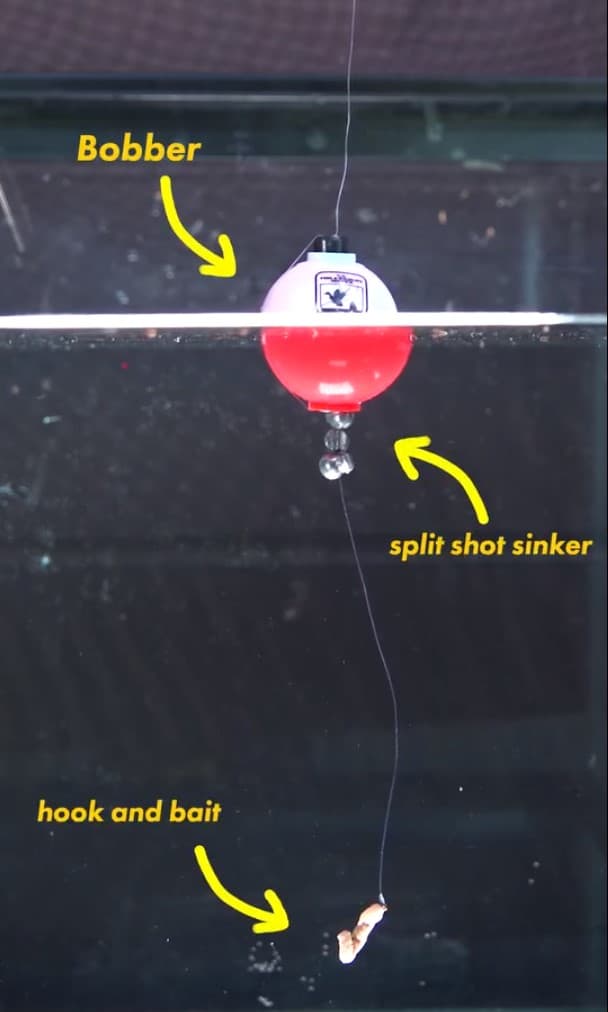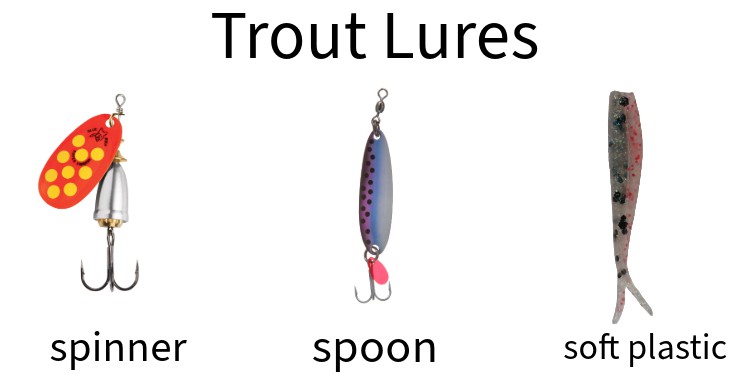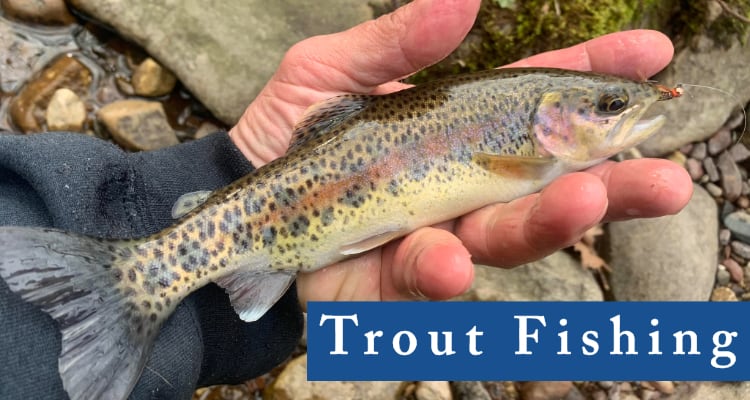Trout is a popular freshwater fish belonging to the Salmonidae family. Trout species vary in appearance and size, but they are often recognized by their elongated bodies, speckled patterns, and small adipose fins. Some common trout species include rainbow trout, brown trout, and brook trout.
This guide will cover the essentials of trout fishing, including the setup, bait, techniques, best times to fish, locations, tips for beginners, and the necessary gear and tools. Trout can range from easy to challenging to catch, depending on the species, location, and conditions. We’ll explore methods primarily targeting freshwater trout species such as Rainbow Trout, Brown Trout, and Brook Trout, providing a comprehensive overview of how to successfully catch these sought-after fish.
Trout Fishing Setup
The most common tackle to catch trout includes a lightweight or ultralight spinning rod and reel combination. This setup is preferred due to its versatility and ease of use for anglers targeting trout in various environments, from streams to lakes. A rod that is 5 to 7 feet in length, paired with a reel that can hold at least 200 yards of 4 to 6-pound test line, is ideal for most trout fishing situations. This size allows for precise casting of small lures and baits, which is crucial for targeting trout.
The best setup for trout fishing often involves using a floating line, as it allows for better control and presentation of the bait or lure. For those using spinning gear, a monofilament line with a 4 to 6-pound test is recommended for its strength and flexibility, providing a good balance between sensitivity and the ability to handle a fighting trout. The light line also makes it less visible to the fish, increasing the chances of a bite.
Regarding rigs, the best rig for trout is the float rig or bobber rig, especially for beginners. This rig consists of a small bobber attached to the line, a split shot sinker placed below the bobber to add weight and depth control, and a hook (size 8 to 12) tied to the end of the line. This setup allows the bait to be suspended at a predetermined depth, making it visible and attractive to trout. The float rig is effective in various conditions, providing both visual indicators of a bite and the ability to adjust the depth of the bait easily. For bait, live worms, minnows, or artificial lures like spinners and small spoons can be highly effective when matched with this rig.

Best Bait For Trout
Trout have a diverse diet that includes insects, small fish, crustaceans, and worms, making them susceptible to a wide range of baits and lures. Their natural feeding habits allow anglers to be flexible in their choice of bait, adapting to the trout’s preferences in different environments and seasons.
The best live bait for trout includes worms, minnows, and insect larvae such as maggots or mealworms. Worms, particularly nightcrawlers or red wigglers, are highly effective because they naturally occur in the trout’s environment, making them an irresistible meal. Minnows are excellent for mimicking small fish that trout prey on, especially in waters where trout are known to feed on other fish. To use live bait effectively, hook the bait in a way that allows it to move naturally in the water. For worms, threading them onto the hook to leave some hanging off creates an enticing action. For minnows, hooking them through the lips or back without impairing their movement is key.
When it comes to artificial lures, the best options for trout include spinners, spoons, and soft plastics designed to mimic the trout’s natural prey. Spinners, with their reflective blades, create vibration and light reflections that attract trout. Casting a spinner upstream and retrieving it at a speed that keeps the blade spinning is an effective way to mimic a fleeing fish. Spoons, with their wobbling action, mimic injured baitfish, and fishing them with a steady retrieve or an occasional twitch can trigger strikes from trout. Soft plastics, especially those resembling worms or small aquatic creatures, can be jigged or retrieved steadily to entice trout.

Additionally, fly fishing with artificial flies that imitate insects at various stages of their life cycle (such as nymphs, emergers, duns, and spinners) can be particularly effective, especially in streams and rivers. The key to using flies is to match the hatch, meaning selecting a fly that resembles the insects that are currently being eaten by trout in the area.
Trout Fishing Techniques
Spinning
Spinning is one of the most common and effective techniques for catching trout. This method involves using a spinning rod and reel, combined with various lures such as spinners, spoons, or small crankbaits. The setup typically includes a lightweight or ultralight rod measuring between 5 to 7 feet, paired with a spinning reel spooled with 4 to 6-pound test monofilament line. This technique is most effective in a wide range of environments, from streams and rivers to lakes. The key to success with spinning is casting your lure to areas where trout are likely to be feeding, such as near underwater structures, in deep pools, or along currents. A steady retrieval, occasionally pausing or twitching the rod tip, can mimic the movement of prey, enticing trout to bite.
Fly Fishing
Fly fishing is a specialized technique highly regarded for its effectiveness in catching trout, particularly in rivers and streams. This method involves using a fly rod and reel, along with a specially designed fly line, leader, and artificial flies that mimic insects or other natural food sources for trout. The setup requires a bit more finesse, with the choice of fly being critical. Flies are chosen based on the current insect hatches occurring in the water, requiring anglers to “match the hatch.” This technique is most effective when trout are actively feeding on the surface or just below it. Casting the fly upstream and allowing it to drift naturally with the current, mimicking a floating insect, can be incredibly effective. Fly fishing is not only productive but also offers a deeply immersive and rewarding experience.
Bait Fishing
Bait fishing is a traditional and widely used technique for catching trout, utilizing live or artificial baits such as worms, minnows, or dough baits. The setup often involves a simple rod and reel combo, with a small hook (size 8 to 12), a split shot weight to keep the bait down, and a bobber to signal bites. This technique can be particularly effective in still waters like lakes or slow-moving parts of rivers and streams. Presenting the bait at the right depth is crucial, as trout tend to feed at specific water columns depending on the time of day and weather conditions. Early morning or late evening, when trout are more actively feeding, is the ideal time to use this technique. Bait fishing allows for a relaxed approach, making it suitable for anglers of all ages and experience levels.
Jigging
Jigging for trout involves using a small jig, often tipped with a piece of live bait or a soft plastic grub, to mimic the movement of prey. This technique can be particularly effective in deeper water or when trout are holding close to the bottom. The setup includes a lightweight rod and reel, with the jig weight chosen based on the depth and current of the water. The technique involves casting the jig out and letting it sink to the desired depth before starting a series of retrieval motions. This can include gentle lifts and falls of the rod tip, causing the jig to bounce and move enticingly through the water. Jigging is most effective in colder months or when trout are less active, as the subtle movement of the jig can trigger strikes from fish that might not chase a faster-moving lure.
Best Time To Catch Trout
The best time to catch trout can vary depending on several factors, including the trout’s spawning cycle, the time of day, and the season. Understanding these factors can significantly increase your chances of success.
- When do trout spawn? Trout spawning times vary by species but often occur in the fall for brown trout and brook trout, and in the spring for rainbow trout.
- Best time of day to catch trout? Early morning and late evening are the best times to catch trout because these periods offer lower light conditions under which trout are more active and feel safer to feed.
- Best time of year to catch trout? Spring and fall are the best times of year to catch trout. In spring, trout are active due to increased metabolic rates with warming waters, and in fall, they feed aggressively in preparation for the winter.
Spring
In spring, the best time to catch trout is during the early morning and late afternoon. As the water temperature starts to warm, trout become more active and feed more aggressively. Fly fishing with nymphs or dry flies can be highly effective as trout are looking to feed on the surface and just below. Spinning with small spinners or spoons that mimic small fish or insects can also be successful.
Summer
During the summer, early morning and late evening are the prime times to target trout, as the day’s cooler periods encourage them to feed more actively. In many areas, summer can bring higher water temperatures, which can reduce trout’s activity during the hotter parts of the day. Fly fishing during hatches or using light spinners in shaded areas or near cooler water inflows can yield good results.
Fall
Fall is an excellent season to catch trout, especially in the early morning and late evening. As the water cools, trout’s feeding activity increases in preparation for winter. This season is ideal for both fly fishing and spinning. Using larger lures or flies that mimic baitfish can be particularly effective, as trout are looking to consume more calories.
Winter
In winter, the best time to catch trout is during the midday, when the water is at its warmest. Trout will be more lethargic during this season, so slow-moving baits and lures are more effective. Fly fishing with small nymphs or using jigs under a bobber can produce good results, as these techniques allow for a slower, more deliberate presentation.
Night
Catching trout at night can be highly productive, especially in the summer when daytime temperatures are high. Trout feel safer and are more active under the cover of darkness. Using lures or baits that create vibration or noise, such as spinners or surface lures, can attract trout’s attention. Additionally, using scented baits or glow-in-the-dark lures can also increase your chances of success. Night fishing requires extra caution and familiarity with the fishing area for safety.
Where To Find Trout
Trout are versatile fish that thrive in various water bodies, making them a popular target for anglers. The best water bodies for trout include streams, rivers, lakes, and ponds.
When fishing for trout, the depth at which to fish can vary greatly depending on the water temperature, time of day, and season. Trout can be found anywhere from just below the surface to depths of over 20 feet, although 2 to 10 feet is a common range for many fishing situations.
Utilizing a fish finder can be incredibly helpful in locating trout, especially in larger lakes and ponds, as it helps identify their depth, underwater structures, and schools of fish.
Streams
Streams are ideal habitats for trout, offering cool, oxygen-rich waters. In streams, trout often position themselves behind rocks or in slower-moving pools to conserve energy while watching for food to pass by. Fly fishing is a highly effective technique in streams, using dry flies or nymphs that mimic the insects trout feed on. A lightweight rod and a floating line can provide the precision needed for casting in tight spots and achieving a natural drift of the fly.
Rivers
Rivers, with their diverse environments, offer excellent opportunities for catching trout. Look for trout in areas where the current slows, such as behind large rocks, log jams, or within bends in the river. Spinning with small spinners or spoons can be very effective, as these lures can cover a lot of water and attract trout in faster currents. Fly fishing with streamers that imitate small baitfish or nymphs can also be successful, especially in areas with slower currents or eddies.
Lakes
Lakes are popular destinations for trout fishing, where fish can be found from shallow waters to deeper zones, depending on the season. Trolling with small spoons or crankbaits can be an effective way to locate and catch trout in larger lakes. When trout are found closer to the surface, casting from a boat or shore with spinners or using a float rig with live bait can yield good results. A fish finder is particularly useful in lakes to identify the depth at which trout are holding, as well as locating underwater structures or drop-offs where trout may congregate.
Ponds
Ponds, especially those that are spring-fed or have running water, can be excellent places for trout fishing. In ponds, trout often cruise the shallows in search of food or hold near structure or cooler water inputs. Using a lightweight spinning setup with live bait like worms or small lures can be very effective. Fly fishing around the edges with wet flies or nymphs can also catch trout feeding below the surface.
Shore
Shore fishing for trout can be particularly rewarding in lakes, ponds, and slow-moving rivers. Casting parallel to the shoreline or towards areas with noticeable structure or vegetation can be effective. Using a lightweight spinning rod with a bobber and live bait, such as worms or minnows, allows you to cover different depths. Spinners and spoons can also be used from the shore to mimic small fish and attract trout.
Tips To Catch Trout For Beginners
- Start with a lightweight or ultralight spinning rod and reel combo for ease of use and better sensitivity to detect bites.
- Use a monofilament line with a 4 to 6-pound test, which offers a good balance of strength and invisibility under water.
- The simplest and most effective bait for beginners is live worms, such as nightcrawlers or red wigglers, because they attract trout naturally.
- To set up your hook, tie a single small hook (size 8 to 12) to the end of your line using an improved clinch knot for security.
- Add a split shot weight about 12 to 24 inches above the hook to ensure your bait sinks to the desired depth but remains natural in its presentation.
- Attach a small bobber or float to your line above the split shot to keep your bait suspended off the bottom and to visually signal when a trout bites.
- Cast your line into areas where trout are likely to be, such as near underwater structures, the edges of streams, or areas with shade in lakes.
- Keep your line slightly taut to feel the trout’s bite; when the bobber dips or jerks, gently set the hook by lifting the rod tip.
- Change your bait frequently to ensure it’s fresh and more appealing to trout.
- Practice catch and release by handling trout carefully and releasing them quickly to preserve the fish population and enjoy the sport for years to come.
Best Trout Fishing Gear And Tools
Selecting the best fishing gear for trout enhances your fishing experience by improving your ability to catch these elusive fish. Here’s a breakdown of the gear and tools you need for trout:
Fishing Rod
The ideal fishing rod for trout is a lightweight or ultralight rod, offering better sensitivity and flexibility, which is crucial for feeling the bite of a trout and for casting small lures or bait with precision. A length of 5 to 7 feet is optimal, providing a good balance between casting distance and control. The rod should have a fast to moderate action, allowing for a responsive feel that helps in setting the hook quickly and effectively while still being flexible enough to absorb the fights of a trout.
Fishing Line
A monofilament line with a 4 to 6-pound test is best suited for trout fishing, offering a combination of invisibility and strength. Monofilament is preferred for its stretch, which can be forgiving on the hook set and help absorb the trout’s fight, reducing the chance of the line breaking. Additionally, it has a lower visibility under water, making it less likely for trout to be spooked by the sight of the line.
Fishing Reel
A spinning reel is the best choice for trout fishing, particularly when paired with a lightweight or ultralight rod. Look for a reel with a smooth drag system, which is essential for handling the sudden runs and pulls of a trout. The reel should be capable of holding at least 100 yards of the 4 to 6-pound test line, ensuring you have enough line for longer casts or to fight a fish without running out. A reel with a high gear ratio is not crucial for trout fishing, but a smooth retrieve and reliable performance are vital.
Fish Finder
For those fishing in larger lakes or ponds, a fish finder can significantly increase your chances of locating trout. The ideal fish finder for trout fishing should have a high sensitivity and the ability to detect fish at various depths, including the shallower areas where trout often feed. Look for a model that offers detailed imaging and can differentiate between fish sizes and structures, which helps in targeting the areas where trout are likely to be. Portable or castable fish finders are great for shore anglers, while boat-mounted models offer more advanced features for serious anglers.

